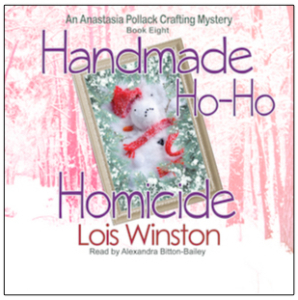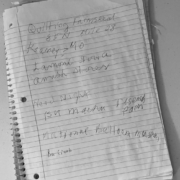Ridding the World of Word Clutter, One Description at a Time
 By Lois Winston
By Lois Winston
I’ve recently had several requests from authors and publishers to write blurbs for soon-to-be-published books. In addition, I’m currently judging a writing contest for recently published novels. Although all mysteries, these books run the gamut of various sub-genres within mystery, everything from cozies to suspense. Disturbingly, I’m seeing one issue that crops up in many of them: over-writing.
Many years ago, the agent who owned the agency that represented me gave me the best writing advise I’ve ever received. He said that every scene and all dialog in a book must do one of two things—either advance the plot or tell the reader something she needs to know about the POV character AT THAT MOMENT. If the scene or dialog does neither, it’s filler and doesn’t belong in your book.
Filler usually manifests in dialog as chit-chat. In narrative, the culprit is often description. Excessive description is the downfall of many of the books I’m reading. Description done well enhances a story. It gives the reader a deeper understanding of the character and the world she inhabits. However, when not done well, description pulls the reader from the story and drags down pacing. No one wants to read a mystery, suspense, or thriller with pacing that induces sleep, but that’s what I’m finding in too many of these books.
Some authors are of the misguided notion that they need to describe all characters from head to toe every time they appear in a scene. They also believe they need to describe every aspect of the setting, from the color of the curtains on the windows to the knickknacks on the shelves. A well-written book only describes that which is pertinent to the character and the scene.
Adjusting your thinking to view filler as word clutter, enables you to adopt a Marie Kondo attitude toward your writing. Doing so will not only aid your pacing but will allow the words that remain to have greater impact.
Here’s an example I’ve used when giving writing workshops. The following is a paragraph describing a fictitious character:
Joe wore a threadbare navy blue and forest green plaid flannel shirt. Two of the buttons were missing, and one was hanging from a loose thread. His legs were encased in bleach-stained black jeans, torn in some places, patched in others. I glanced down at his feet. The cuffs of his jeans were frayed, and his big toe peeked out from a hole in the top of his scuffed and dirt-caked tan work boots. A ratty, stained camouflage ball cap sat sideways on a head.
And this is a one-sentence description of that character that says the same thing in only five words:
Joe wore Salvation Army rejects.
There is no reason to use eighty-two words to describe something that can be described in five—not to mention, described better. Unless there is something about Joe’s clothing that will have an impact on the plot or one of the other characters, the reader doesn’t need to be pulled from the story by having to focus on such minute details. Less is more.
Do you have a pet peeve about books you’ve been reading lately? Post a comment for a chance to win a promo code for a free audiobook of Handmade Ho-Ho Homicide, the eighth book in my Anastasia Pollack Crafting Mysteries.
~*~
USA Today and Amazon bestselling and award-winning author Lois Winston writes mystery, romance, romantic suspense, chick lit, women’s fiction, children’s chapter books, and nonfiction under her own name and her Emma Carlyle pen name. Kirkus Reviews dubbed her critically acclaimed Anastasia Pollack Crafting Mystery series, “North Jersey’s more mature answer to Stephanie Plum.” In addition, Lois is a former literary agent and an award-winning craft and needlework designer who often draws much of her source material for both her characters and plots from her experiences in the crafts industry. Learn more about Lois and her books at her website www.loiswinston.com where you can also sign up for her newsletter and follow her on various social media sites.










I was with you, nodding along, until you gave the example. I am not generally a fan of over description, but I really liked that paragraph you gave. Not saying the 5 word sentence is bad, and they both paint great pictures. I think there is a place for both. And I’d hate to hear about what Joe is wearing each time he steps on page. (No need to enter me in the giveaway.)
Mark, once or twice is not a problem if there’s a reason for it, but there has to be a reason. The problem, though, is that any writer prone to over-describing will usually do so throughout the the manuscript, and that’s really going to drag down the pacing.
Love your illustration. I doubt most writers can come up with such a quick turn of words, but they definitely can pare down the long paragraph of filler. Good post.
Thanks, Debra!
This post reminds me of a writer from one of my critique groups, who wrote an atmospheric novel in an exotic setting, and the descriptions were lush and eloquent. One of the critiquers detested the long passages of description, but I found them luxurious, and felt they did a lot to support the surrealistic quality of the plot. Generally, I agree that over-writing is rampant in many of today’s books, but once in a while, a book needs it.
Saralyn, I think the key is knowing when it’s too much. Description is an important part of a novel because it sets the mood and tone, but less is usually more because the author isn’t writing a travelogue or a piece for a fashion magazine.
I agree.
Great advice, Lois. Sometimes, we get lost in our words.
True, Kathleen. And sometimes we fall too much in love with our words!
Lois, when I read your example description I wondered what it was meant to tell us about the character(s). If Joe is the PoV character, there may be a reason he’s so conscious of what he’s wearing. If the observer is the PoV character, could that detailed description tell us something about her or him? What kind of character would observe another character so closely and, probably, critically?
Both of these questions point to ways in which the description can be “pertinent to the character and the scene.”
My wife reads a lot of historical mysteries these days and is often put off by the detailed descriptions of clothing and rooms. But these books sell. I suspect there are a lot of readers who get into these detailed descriptions. Maybe they’re clothing geeks or historical-interiors geeks. She and I agree about certain contemporary-set novels that go way overboard on descriptions of clothes that don’t advance the story or characterization.
I was studying the beginnings of an Ann Cleeves novel recently and noticed how many of the descriptive paragraphs that set things up have some kind of “dramatic” component.
Eric, I think your last sentence is key. There has to be a reason for the description. Otherwise, it’s filler.
In the example I gave, I should have clarified that Joe is not a major character in this imaginary book. He appears in one brief scene. If Joe were a pivotal character, there might be a reason for the author to go into more detail about what he looks like and what he’s wearing. The problem is that many writers don’t differentiate between the characters and scenes in their books when it comes to description. EVERYTHING gets described, whether it’s necessary to the story or not. My point is that there must be a reason for the description.
Unless a long description is a masterful piece of writing, I tend to skip over it and keep reading. The thing that throws me out of a book faster than anything is trite or over-long dialogue. It makes for an unnatural stiffness to the characters that kills my interest in them. Good post, Lois.
Thanks, Gay! Yes, trite dialogue also falls under the word clutter category. Dialogue needs to advance the plot or tell the reader something she needs to know at that moment about the characters. Otherwise, it’s filler.
What a good post! I’m reminded of a free-writing exercise about filling a whole page with, for example, what the character is wearing. In the second step, rewrite, paring the page to one paragraph. Then rewrite again paring it to one sentence. I use this expansion/contraction technique in revisions when deciding what should stay and what must go. It helps but is hard work.
I don’t mind descriptions however I do become weary of repetition. I recently read a book where every chapter seemed to remind me that “she was recently divorced.”
Barb, that’s a great exercise. And yes, repetition also drives me crazy when I’m reading a book. Readers are not stupid. We don’t need to beat them over the head repeatedly with the same facts. The worst example of this was a romantic suspense I read at least fifteen or twenty years ago. On every page, the author repeatedly mentioned the sardonic attitude of a certain character. She used “sardonic” and “sardonically” so often that at one point I grabbed a highlighter and started marking up the pages every time I came across those two words!
In thinking about this more, I’ve been thinking about Sue Grafton. One thing I’ve loved about her books is that she can make even minor characters come to life with just a few sentences without slowing down the book. It’s definitely something that takes hard work, but when it is done well, readers appreciate it.
Absolutely, Mark!
Lois, Very helpful post. I may be guilty of just what you’re describing, so I’m going to keep this post in mind when I go through my first draft. I really loved the example!
Thanks, Merissa. Glad you found it helpful.
Good advice.
Excellent post and what a great example! I agree with you, and my natural style is to write sparingly with the descriptions – so much so that my editor asks for more detail.